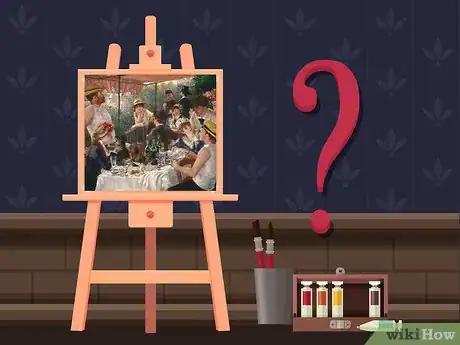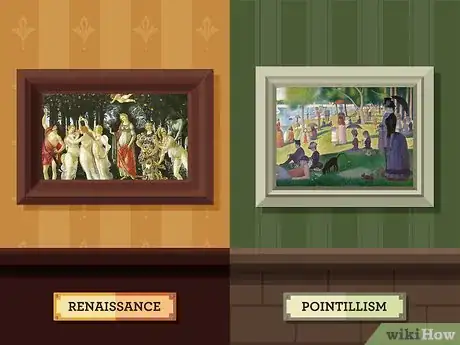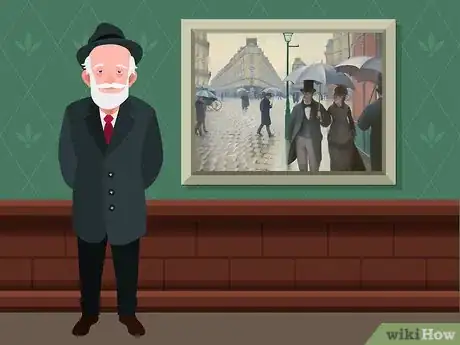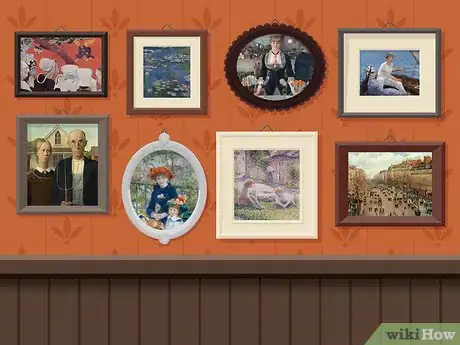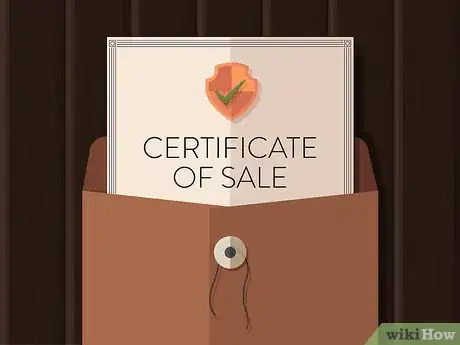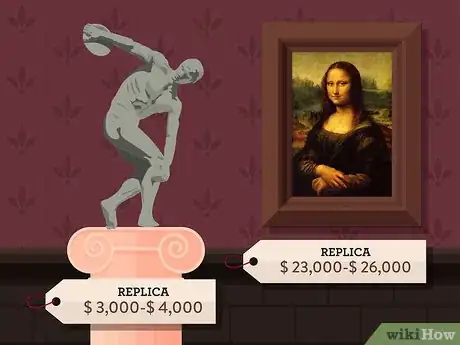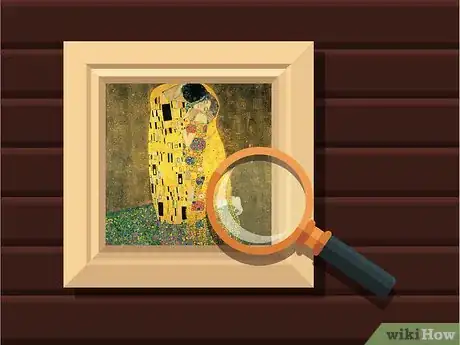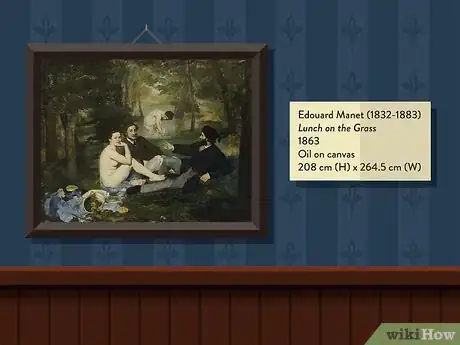wikiHow is a “wiki,” similar to Wikipedia, which means that many of our articles are co-written by multiple authors. To create this article, volunteer authors worked to edit and improve it over time.
There are 7 references cited in this article, which can be found at the bottom of the page.
This article has been viewed 111,815 times.
Learn more...
Valuing art is the act of placing a dollar value on a painting, sculpture, or other artistic work. Appraising is an art, not a science, and market trends can quickly cause fluctuations in prices. While most people hire an appraisal expert in order to arrive at a dollar value, it's possible to arrive at an estimate yourself with just a few pieces of information. Whether you've just bought a piece of art, are preparing to sell one, or are simply curious, here's how to make your appraisal a lot less arbitrary.
Steps
Looking at the Art Itself
-
1Research the artist's output. How many works of art did the artist complete? The output of the artist in general greatly affects price. Prolific artists' pieces of work tend to be less valuable than those of artists who simply produced less, all things being equal.
-
2Find out if there are duplicates. Is the work one-of-a-kind? Because of supply and demand, works that are singular are worth more than replicated works. For this reason, a paintings is usually worth more than a print or a lithograph — there are simply fewer of them out on the market.Advertisement
-
3Pinpoint when in the artist's career the work was completed. Was the work completed early on or toward the twilight of their career? Interestingly enough, works of art completed early in artists' careers are usually valued higher than those completed later on.[1]
- Why is this? Although it's not true in all cases, early work tends to be more daring, passionate, and unpredictable, sometimes owing to the artist's desire to establish a reputation for him or herself. Many appraisers believe that as an artist becomes more established in their career, their art loses some of its derring-do and boldness. This artistic predictability is sometimes factored into the valuation.
-
4Ask yourself if the work epitomizes the artist's style. Works of art that epitomize an artist's aesthetic are usually appraised higher than works of art that are tangential or not representative of the artist's oeuvre.
- Pablo Picasso's art is indelibly linked to an artistic movement called cubism. Currently, Picasso's most expensive painting, Le Rêve, which was sold in early 2013 for $155 million, falls firmly in that aesthetic.[2] It is very emblematic of Picasso's style in general.
-
5Investigate whether the artist is well-known or has a reputation. Artists generally fall into three categories of renown: well-known, up-and-coming, and unknown. Artists who are well-known and have a rich history of collection can almost always command more value more than artists who are unknown.
- How much buzz is the artist attracting? The more mentions they get in significant publications, the better.
- Does the artist have any significant showings in galleries, or did they in the past? Has the artist received acclaim from other art institutions, such an prizes, awards, or achievement recognition?
- Do any museums own the artist's work? Artists who find homes for their art in museums can expect a significant uptick in the value of their work.
-
6Know that size matters. Generally, bigger works of art are appraised higher than smaller ones, usually because of the degree of difficulty involved.
-
7Find out if the piece of art has ever been owned by someone renowned. Barring the artist themselves, works of art that were formerly owned by someone famous or well-known can command much higher prices than those pieces who don't ha or condition issues. An item that is ripped, water-damaged, discolored, or otherwise damaged can return significantly less than an item that is in perfect shape.[3] Note that an item that isn't technically damaged but isn't as vibrant as it was when first completed will qualify as having a "condition issue."
- Cleaning up an artwork or fixing condition issues can have a significant impact on its value. Cleaning up and fixing condition issues on an artwork can improve its bottom line up to 20%.
Taking the Market's Pulse
-
1Investigate market demand. In short, how many people want to buy the piece of art? Art is sold in a market. This means that the value of items offered in the market fluctuates depending on how much buyers want the piece, as well as how much they are willing to pay. Ask yourself if the market is in a peak, where demand is usually high, or a trough, where demand is depressed.
- If a glut of pieces enter the market, the market price tends to go down; if pieces are sold off or if a new group of buyers suddenly becomes active, the market price tends to go up. This is often referred to as supply and demand.
-
2Look at liquidity. Liquidity, also called marketability, is the reliability with which an asset or security can be sold without affecting its asking price.[4] In the art world, high liquidity means that it's relatively easy to sell an item quickly and thus convert its value into cash. Low liquidity means that it's harder to do this, creating a barrier to converting an asset into cash.
-
3Look at market trends. Related to demand, pricing trends are usually the result of changes in people's perceptions of art or changes in their material circumstances.
- In the early 2010s, Chinese billionaires, flush with money, began buying Asian art, sending demand significantly higher and signalling a new trend in the market.[5]
- As a result of this trend, Indian and Asian art became a hot commodity in the art world. Collectors are willing to pay more of a premium for art in this market.
-
4Place the art in a primary or secondary market. Has the work of art been sold before? The primary market is what the work of art is valued at when it is first sold. The secondary market is what the work of art is valued at after it has been sold at least once. The secondary market value has a direct relation to what the item was sold for in the primary market.[6]
- One of the things you want to look out for is a certificate of sale, especially if your item has been purchased at an auction. Referencing this document will make your ultimate appraisal much less subjective.
Arriving at a Final Price
-
1Look at what other, similar pieces of art have sold for. If you've just bough an impressionist painting in the vein of a painting that was just sold for $12,000 — all other things being equal — that should give you a good benchmark for what your painting may be worth.
- When looking at comparables, use a price range instead of a single price. Art appraisers generally say, for example, that a sculpture is worth in the $800 - $1,200 range instead of saying it's worth $1,000.
-
2Know that one-of-a-kind artworks are difficult to price, and somewhat more subject to change. An artwork that is truly unique and doesn't have any other analogues against which to compare it is difficult to value. The appraisal arrived at is considered to be especially volatile.
-
3Look at scale, intensity, and medium. Scale is the size of the artwork and the level of detail. Intensity is the level of effort put into the artwork. Medium is the quality of the materials used. Combine these three aspects together and you should have a better idea of what your artwork is worth.[7]
Community Q&A
-
QuestionIs a Picasso reprint worth anything?
 Community AnswerAlmost certainly not. If the reprint was signed by Picasso, it's worth more than the price of the signature, but the price of the reprint will pale in comparison to the price of an original edition. An original print is a copy made from a printing plate, from which the artist makes a limited edition of prints. A reprint is a copy of the print — essentially a copy of a copy — and not necessarily made directly by the artist or her helpers. An almost unlimited amount of copies can be made of reprints. Therefore, their main value lies in their sentimental appeal.
Community AnswerAlmost certainly not. If the reprint was signed by Picasso, it's worth more than the price of the signature, but the price of the reprint will pale in comparison to the price of an original edition. An original print is a copy made from a printing plate, from which the artist makes a limited edition of prints. A reprint is a copy of the print — essentially a copy of a copy — and not necessarily made directly by the artist or her helpers. An almost unlimited amount of copies can be made of reprints. Therefore, their main value lies in their sentimental appeal. -
QuestionHow can I get my art appraised?
 Community AnswerGo to an art appraiser or an estate retailer and ask them to appraise your artwork. They may charge a small fee, however. You can also try a collective gallery or art co-op.
Community AnswerGo to an art appraiser or an estate retailer and ask them to appraise your artwork. They may charge a small fee, however. You can also try a collective gallery or art co-op. -
QuestionIs an original painting more valuable if it is published in prints?
 Community AnswerIt's tough to say. A work's value probably depends more on factors like quality, scale, intensity, and current market trends than whether an artist or publisher decides to make prints or even reprints. On the one hand, the prints might stoke excitement and help drive demand. On the other hand, prints mean more supply, which decreases valuation. If your original painting is from a well-established master, it probably doesn't affect the valuation. If your original painting is from a less well-known artist, it may hurt the value of your original.
Community AnswerIt's tough to say. A work's value probably depends more on factors like quality, scale, intensity, and current market trends than whether an artist or publisher decides to make prints or even reprints. On the one hand, the prints might stoke excitement and help drive demand. On the other hand, prints mean more supply, which decreases valuation. If your original painting is from a well-established master, it probably doesn't affect the valuation. If your original painting is from a less well-known artist, it may hurt the value of your original.
References
- ↑ http://www.artbusiness.com/early.html
- ↑ http://www.dailymail.co.uk/news/article-2299403/Hedge-fund-billionaire-buys-Picassos-Le-R-ve-155m--16m-MORE-price-agreed-previous-owner-tore-hole-elbow.html?ito=feeds-newsxml
- ↑ http://www.askart.com/AskART/help/what_is_my_art_worth.aspx
- ↑ http://www.investopedia.com/terms/l/liquidity.asp
- ↑ http://www.usnews.com/news/articles/2012/04/27/the-scream-sale-could-continue-global-art-shift
- ↑ http://www.investopedia.com/articles/02/101102.asp
- ↑ https://www.npr.org/transcripts/128084948?storyId=128084948


